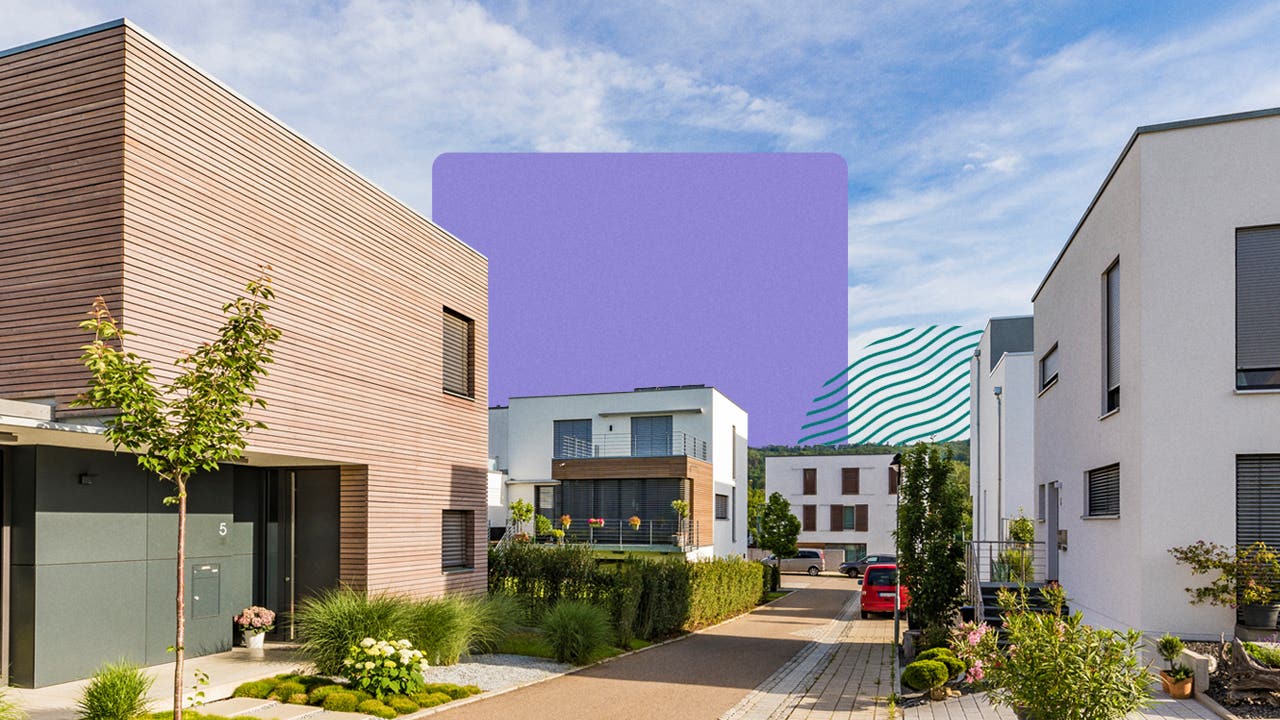Housing market predictions: The forecast for the next 5 years

It’s been a wild real estate ride in the five years since the pandemic. First, a red-hot market brought rising home values and frenzied bidding wars, with high buyer demand fueled by mortgage rates as low as 3 percent in 2021. But then rates started increasing, reaching 8 percent — their highest level in more than 20 years — in late 2023. Would-be sellers stopped selling, which shrank inventory, and prices continued rising, pricing out many would-be buyers.
What ups and downs will this roller coaster hit over the next five years? We asked several industry experts to give us their best real estate predictions.
Real estate forecasts for the next 5 years
As of today, the roller coaster keeps on rolling: Housing inventory is growing but still low, with prices and mortgage rates still high. The market seems to be thawing a bit, though: The National Association of Realtors (NAR) predicts existing-home sales will be up 7 to 12 percent in 2025 and 10 to 15 percent next year.
Before we peer into our crystal ball, let’s take a snapshot of how things stand currently. “If a first-time homebuyer retreated to the sidelines during the last couple of years, the conditions are slightly better now,” says Jessica Lautz, NAR’s deputy chief economist and VP of research. “There are fewer bidding wars for homes, and we’re starting to see more inventory come to the market. Interest rates have stabilized, the job market is strong and home prices are still growing, but not at rates as high as before.”
-
Home sale prices: The country’s median existing-home sale price in January 2025 was $396,900, according to NAR. That’s a 4.8 percent increase over last year and a record high for January.
-
Inventory: The supply of homes for sale is increasing, but not fast enough. Per NAR data, the inventory of unsold existing homes was at 1.18 million units in January 2025. While that’s up a significant 16.8 percent from one year earlier, it’s still only a 3.5-month supply, well below the 5 to 6 months a balanced market would typically require.
-
Days on market: With lofty prices and high mortgage rates still putting a purchase out of reach for many, homes are taking slightly longer to sell. In January 2025, the median length of time homes spent on the market was 41 days, up from 36 days one year earlier.
-
Homes sold: Sales of existing homes increased a bit in January 2025 — up 2 percent from a year ago and the fourth straight monthly increase.
-
Mortgage rates: According to Bankrate’s weekly survey of large lenders, the average 30-year fixed mortgage rate as of early March was 6.72 percent.
There are plenty of predictions about where the housing market is going this year. But what about further out? After all, buying a home often requires long-term planning.
Despite many changes and wildcards — like new tariffs on goods from China, Canada and Mexico, which will likely have a profound impact on the homebuilding industry — here are some top experts’ best guesses for what’s on the horizon.
Will we shift into a buyer’s market?
It’s debatable. Lautz expects the current seller’s market to persist: “To be a balanced market, there would need to be more housing inventory,” she says. “The struggle has been the lack of inventory — in the U.S., we’re short about 5 million homes nationwide. As we ended 2024, more inventory started coming to market, but it has not been consistent.”
On the other hand, Chen Zhao, who leads the economics team at Redfin, sees the market starting to shift in buyers’ favor. She predicts the mortgage lock-in effect will ease over the next few years (barring a severely disruptive macroeconomic event). “The process of shaking off the hangover from the extended period of very low rates is still going, and will be going for a while,” she says. “We’re already seeing softness in some markets in the south, predominantly in Texas and Florida due to abundant supply and climate risk.”
Predictions for mortgage rates and home prices
Zhao doesn’t see mortgage rates coming down significantly any time soon. “Mortgage rates are likely to remain high, but volatile,” she predicts. “They’re being driven by two things right now: One, economic conditions and Fed policy, and two, expectations for fiscal and trade policy dictated by the White House and Congress.”
NAR expects rates will stabilize, hovering around 6 percent through 2026. One positive: Although 6 percent is much higher than the super-low rates of 2020 and 2021, it’s still “a full percentage point lower than the historical average of 7.74 percent, when you date back to 1971,” says Lautz.
Thirty-year fixed mortgages continue to be the most popular mortgage type, Lautz added. Mark Hamrick, Bankrate’s senior economic analyst, doesn’t think that will change: “People like and benefit from the predictability of monthly payments, given that housing affordability remains extremely challenging in the current environment,” he says.
As far as prices go, NAR predicts that the median home price will increase 2 percent this year and another 2 percent in 2026. That’s a relatively small increase, says Lautz, especially compared with double-digit gains in recent years. With increases in most parts of the country now in the single digits, she says, the playing field should become more level for first-time buyers.
Where will new homes be built, and what kind?
The South dominated building in 2024, with 9 of the top 10 largest markets for single-family home construction (by permits) located in Texas and the Southeast, according to data from the National Association of Home Building (NAHB). Texas, Florida and North Carolina were the states with the highest number of single-family permits issued. Data does not show any signs of this geographic dominance ending anytime soon.
Single-family homes continue to be the most popular housing type, with a significant amount of new development focused on townhouses. Their construction grew 10 percent over the course of 2024 and comprised nearly 20 percent of new single-family starts in the fourth quarter of the year. While multifamily housing construction grew in 22 states, it was down 12.8 percent overall for the year.
That said, federal policy changes by the Trump administration make forecasting the future of homebuilding tricky. “Tariffs on lumber are a near-term concern, with the existing duty rate expected to increase from a current 14.5 percent rate to nearly 40 percent later this year,” says Danushka Nanayakkara-Skillington, NAHB’s assistant VP for forecasting and analysis. “This is why regulatory reform that reduces the cost of land development, home construction and remodeling is now even more critical for improving housing attainability.”
Concerns regarding immigration and workforce availability could also pose a risk, she added. But, “if construction growth remains steadily positive through the start of 2025, anticipated Federal Reserve rate cuts later this year could help spur new construction and keep single-family homebuilding at a more normalized pace.”
One more potential bright spot: “Previously used office space is being converted to multifamily units in some large markets, helping to address housing undersupply,” notes Hamrick.
Will the housing market crash?
Probably not in the near future, says Lautz. First, home values are more than holding their own, which runs counter to an imminent market crash. Even in the typically slow winter market, “there’s plenty of demand for very limited housing inventory,” she says.
Second, lending standards are much stricter now than during the Great Recession. Mortgage lenders are largely not issuing loans that borrowers can’t really afford anymore, and those who do borrow tend to have excellent credit, which helps keep foreclosure rates low. “Very few people are selling distressed property right now,” Lautz says.
Tips for preparing to buy a home
Buying a house is a major commitment, and starting to save five years in advance is perfectly reasonable. Here are some strategies to get your finances in shape so you can become a homeowner by 2030.
- Decrease your debt: Saving up to purchase a home isn’t just about growing your bank account. It’s equally important to pay down the amount of money you owe on things like credit cards, student loans and car payments. By lowering your debt-to-income ratio, you’ll be in a better position to qualify for a mortgage down the line.
- Expand your income: Switching jobs is usually the fastest path to a significant salary bump, so be willing to look for other opportunities to increase your earning power. If a new job is not an option, think about picking up a side hustle or the best ways to ask your employer for a raise.
- Improve your credit score: The higher your credit score, the lower mortgage rate you’re likely to qualify for when you’re ready to buy. Most mortgage types require a minimum score of 620 to qualify, but higher is better. So, pay your bills on time and do what you can to raise your credit score before you start house-hunting — it could save you a lot of money in the long run.
- Focus on your local area: When you’re ready to buy, remember real estate is hyper-localized, varying greatly not just by region or state but even within the same city or town. Broad national trends are important to bear in mind, but as you budget and save, focus on conditions in the specific neighborhood where you’re looking. This is where a knowledgeable local real estate agent can really shine: Agents are experts in their markets, so find one you like and let their expertise work for you.
Why we ask for feedback Your feedback helps us improve our content and services. It takes less than a minute to complete.
Your responses are anonymous and will only be used for improving our website.
You may also like

Housing market predictions for the rest of 2025





